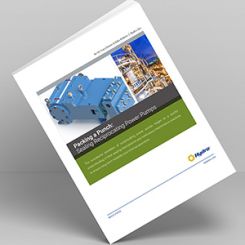Pumping Prescriptions
Pumping Machinery LLC
09/11/2017
This column will examine two indirect methods of determining pump flow in the field:
- pressure (head) measurement
- power (amps) measurement
 Figure 1. Pump performance curve in a combined format. (Source: 2004 Goulds Pumps Manual, ITT Industries)
Figure 1. Pump performance curve in a combined format. (Source: 2004 Goulds Pumps Manual, ITT Industries) Figure 2. Pump performance curve in a single-line format.
Figure 2. Pump performance curve in a single-line format. Pressure (Head) Method
Let’s assume that the discharge gauge reads 55 pounds per square inch gauge (psig) and the suction gauge reads 10 psig, thus a 45 psi pressure differential exists. This would correspond to 45 x 2.31 = 104 ft head (assuming cold water, specific gravity = 1.0). A horizontal 104 ft head line intersects the H-Q curve (at the proper impeller diameter, which is 5.12 inches in this case) at a little less than rated flow, approximately at 60 gpm.Power (Amps) Method
The power curve indicates approximately 3.2 horsepower (hp) at the rated point. Power meters (kW-meter) are rarely available, with amps and volts being more commonly displayed at the control panel. Power can be calculated from these readings, although some assumptions of the power factor and motor efficiency would be required: BHP = (I x V x 1.73 x EFFmotor x PF) / 1,000 Equation 1 In our example, a 5 hp 460 volt (V) motor is used and we actually read 450 V and 3.9 amps. A typical assumption of the product (EFFmotor x PF) is 0.85, although a somewhat better value can be obtained if one is willing to spend some more time on research work. Thus, in our example: BHP = (3.9 x 450 x 1.73 x 0.85) / 1,000 = 2.6 hp Equation 2 This is slightly less than the expected 3.2 hp, meaning a straight horizontal line at 2.6 hp intersects the power curve at flow approximately 50 gpm, depending how accurately you eyeball the curve. Obviously, too many assumptions and approximations in reading curves bring bad news. However, the good news is that based on two methods, we can state that the flow appears to be somewhere between 50 gpm and 60 gpm. For many troubleshooting purposes, this answer is sufficient. As a note on the power method, some people feel more comfortable simply taking the ratio of actual amps to the motor nameplate amps rating, then multiplying the result on motor rated power. In our example, if the motor rated amps were 8.5 amps and rated motor power 5 hp, we could then assume the actual power is 3.9 / 8.5 x 5 = 2.3 hp. This is close to the 2.6 hp value we derived earlier by using a power factor and motor efficiency assumption. The power method can be applied very successfully for field troubleshooting of many pump types, but it has significant drawbacks and cannot be applied for high specific speed (Ns) pumps, such as mixed flow and vertical turbine pumps. Figure 3. Comparison of impeller profiles for various specific speed designs.
Figure 3. Comparison of impeller profiles for various specific speed designs.
To read more Pumping Prescriptions columns, click here.

